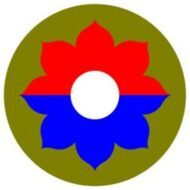“The Ultimate Game” by Gene Harvey
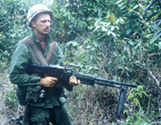
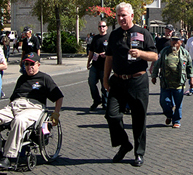
The Ultimate Game The Battle of The Rice Paddy Angle
– May 15, 1967 –
PROLOGUE:
If there is one thing that I have learned in life… it is that practice does not make perfect but rather that practice makes permanent. The lesson here is to practice only things that are correct, right and true… .. otherwise you just end up with a bad habit. I first learned the value of good practice in my high school years but the lesson and the message was much further reinforced during my time with the US Army.
In high school, we are introduced to the concept of practice in sports. Basketball practice, baseball practice, football practice – this was a concept so profound, that it did not need to be explained. Like those in theatre arts, we needed to rehearse before we had an actual, real game against a rival school.
I found out that I wasn’t the best in any sport in which I participated. I had friends, however, that did excel in sports though. Some of this I reasoned to be some natural ability that my friends must possess, but I also noticed that some friends started out at about my same level and became much better than I had because they spent a lot more time practicing. These were my formative years and this is when I first started to figure it out. It was simple, they were more serious than I was, and they deserved their achievements. If I were to have achievements, I guess that I too would need to get serious in my endeavors.
I had graduated high school in the summer of 1963, and chose to play around for a couple of “American Graffiti” summers, cruising the boulevard, looking for car races and girls. But eventually, I started thinking that I wanted much more out of life than it seemed was being handed to me at that time. I decided that I deserved more. I guess I had come to think highly of myself but had also finally (and fortunately) realized that things were not going to be handed to me without me working for it. I needed to actualize my high school lesson of working for what one wanted. Thus, I finally applied for and entered college and had soon fallen into a comfortable routine of being a full time college student. Although I was still living at home with my parents, in North Hollywood, California, I still needed money to pay for my tuition and my textbooks, along with gas money and whatever else it took to keep my old ’53 Chevy running. I needed a part time job.
At that time, restaurant/bar style kegs of beer for the home were becoming the new rage and many people were buying home beer keg dispensers and the like. I took a part time job in Hollywood delivering keg beer to the stars. I had always considered that I possessed more than my fair share of good luck. This is something that I felt early in life and from time to time I was fortunate to be reminded of this. Good luck had come again as my life had then become perfect. I had an income and free beer (I got to keep Dean Martin’s leftover beer) and I was still able to continue college full time. I realized that, although this job was a dream job, the dream couldn’t last. I soon found that I thought too highly of myself to continue to be the ‘beer boy’. I concluded that it would be wise for me to stay in college. Besides, it was not a small thought of mine that by remaining as a full time student in college, I would continue to keep my student deferral with the draft board.
However, I eventually found that I had trouble attending a one-unit slide-rule class that I had. This one-unit class met only once per week and I could not seem to manage my time for what seemingly was an inconsequential college class. Hey, computers were going to be the wave of the future anyway. I dropped this class�.. and I think it was just a couple of weeks later that I received my military draft notice. . I had thought I had been lucky, and maybe I was� but it turned out I was also stupid.
CAREER CHANGE:
On May 17th 1966, many young men, from all around the country, and I were inducted into the US Army to help (re)establish the mighty 9th Infantry Division; ‘the old reliables’. So, for the remaining months of 1966, we would find ourselves in another kind of practice-makes-permanent. High school sports were behind us but practicing for the big game was still the order of the day. At that time, with the USA approaching the height of the Vietnam War, being inducted into the Army was being inducted into the ultimate practice for the ultimate game. �and we all knew it.
What we thought we knew then, however, we probably only knew in vague terms. On Sunday May 15th 1966, on the final weekend before our actual induction, I finished up the rest of Dean Martin’s leftover beer that I had brought home, while I tried to comprehend what was to come. I don’t think that I (and I suppose many others) could really grasp what any of this might mean one year later on May 15th 1967, (and also in the later big battles), deep in the Mekong Delta of Vietnam.
After induction, we ended up at Ft. Riley, Kansas and for the remaining months of 1966, we were taught the art of the infantryman. We were well-rehearsed (the Army calls it “training”: -Basic Training, -Advanced Infantry Training and -Advanced Unit Training, etc). Suffice to say that in those many months we became well-trained, well-practiced, and proficient. We became weapons skilled; we were map-reading experts; we were tactics talented, and we became infantry specialists. In short, we became professional US Army infantry soldiers.
I later was to realize that my good luck had somehow still remained with me when, from the start of our training, I was assigned to Charlie Company, 4th Battalion, 47th infantry. I didn’t know it then, but I had been placed with what turned out to be soldiers that were the best-of-the-best. Our training at Ft. Riley brought out the best of everyone, and sometimes the worst. I’m convinced, though, that the Army had a way to weed out the few mentally weak leaving only the elite at the end of our training. Also, and I need to make this point strongly, we were not being trained as replacements! We were going to Vietnam together as a unit. Throughout the latter half of 1966, the Army broke us down and built us up into a team of friends and buddies that would have each other’s backs. We were molded into a cohesive unit and by the end of 1966, we were ready. We trained together, we played together, and in January, we were going to war�
Timeline � January 1967 � U.S. Navy forms the Mobile Riverine Force, Task Force 117
to support the 9th Infantry Division in their Mekong Delta operations.
As our trip to Vietnam was not that of individual replacements, we traveled together in a troop transport ship, the USNS General John Pope. A half of a month later we were in Vietnam. A lot of our action for the first part of 1967 consisted of a wide variety of actions from good sized helicopter assaults to smaller three-day ambush patrols in the Mekong tidal swamps known as the Rung Sat Special Zone. There are a bunch of stories that could be told from those early days from mid-January to mid-May, 1967, but these stories will be saved for another time. Mostly, I will focus on the battle of May 15th�. not a particularly significant battle as battles go, but it was significant to me. All in all, I feel that it should be chronicled for its small part in history. Some days before the battle of May 15 1967, I was approaching one year in the US Army, roughly seven months in training and five months in combat. I still had seven months remaining before I would complete my requisite one-year tour of duty in Vietnam. I sought out our platoon lieutenant and told him that I wanted to explore the idea of an Army career �but only as an officer. I have already divulged to you that I must have thought very highly of myself in those youthful days – not necessarily a bad trait if not taken to excess. Although, I certainly harbored secret doubts about myself too. After all, even though I was older than most draftees (I had just only turned 21 when drafted) I was still exploring my psyche. Although I did have a firm grasp on at least one part of my psyche. In high school, I had read The Power of Positive Thinking, by Dr. Norman Vincent Peale. A couple of quotes from the good Doctor:
- “A positive mental attitude is a belief that things are going to turn out well, and that you can overcome any kind of trouble or difficulty.” �and
- “Drop the idea that you are Atlas carrying the world on your shoulders. The world would go on even without you. Don’t take yourself so seriously.”
- I had decided to strike a balance between the two extremes, but to try and lean towards the former.
In response to my query to the lieutenant, he explained that to do this I would still need to complete my one-year tour of duty in country (Vietnam). But, he recommended that I apply for transfer to some sort of command support position and remove myself from the job of infantryman. My first thought was, “I can do this? �get a transfer just for the asking?” Well, as it turns out, not exactly; the only way to accomplish this was to reenlist for an additional two years (added to my original two year draft commitment). Thus, I would no longer be just a draftee; I would become regular army ..and, I also could take advantage of the one break I thought I had. In junior high school, circa 1959/1960, in order to improve my luck with the ladies, I took two (count them: ‘two’) semesters of typing class. It worked pretty well as I was one of only two boys in the class surrounded by 20+ girls. I found this tactic worked particularly good at the Friday night Sock-hops. But, damn if I didn’t also learn how to type� both accurately and fast (an early lesson in practice-makes-permanent). I hoped that this was my lucky break as I could perhaps qualify for a transfer to an Army office job in Saigon for the rest of my tour. I would become what was scornfully referred to as a REMF (Rear Echelon M.F), or perhaps less contemptuously as a “Remington Raider”. However, it was my theory that this was going to allow me to gain valuable experience for any future perceived career as an officer. Besides, what would it matter if I signed up for another two years if I was to make the Army a career?
However, at that time, I did not realize the better lessons that I was to learn out there in the field of battle.
Timeline � March 1967 � U.S. aid to South Vietnam is increased by $150 million to bring
the total for the year to $700 million (i.e., approximately $4.5 billion in 2009 dollars).
SHOULD I STAY OR SHOULD I GO?
Still, I had doubts about leaving. I had bonded with many of my buddies. We had been together almost a year. I was part of the team and that was a strong force within me. Not that I wasn’t sure about leaving behind the fun that I was having with our ambush patrols�. the mosquitoes, the delta mud, the very large red ants, the snakes, the mangrove marshes (being immersed in brackish tidewater while we set up night ambushes for the Viet Cong in the “Rung Sat Special Zone”), the river currents running stronger than me while trying to get to the opposite river bank whenever the tide was rushing in (or ebbing out), the enemy’s booby traps, the Viet Cong ambushing us instead of us them. And, the 115-degree heat – and not a dry heat either, like I had been comfortable with back in the southwest USA. It was more like Florida on steroids.
But actually, I joke some here, none of this stuff bothered me, really. You see, it was all part of the game. We had practiced long and well for this. We were in the big game, and all I wanted to do was win. I wanted my buddies to win. I wanted our team to win. Hooray for our school. And, even if I got a little bumped around, it was part of the game and I was young and strong and could handle it. Besides, there was a secret that I held: I was living an exciting adventure. It certainly seemed to be the opposite of boring.
I think however, that during some of this time in Vietnam, I may have started to disconnect from reality somewhat. Looking back, it was perhaps as though I was playing some sort of fantasy role-playing game. With apologies to the Dungeons and Dragons crowd, I think I wasn’t always just playing a character, there were times I was the character. On the other hand, I expect that a more accurate way to describe my mental state of being is to say it was more like being immersed inside one of the many war movies that I had grown up with. Games and war-glory movies aside, there was shame in this thinking. People were killing for real here, and being killed. I was having trouble enjoying the game while still reconciling with the real death part.
So do I stay or go? I hadn’t actually committed to anything yet. The desire to become an officer was strong. But, I would continue to think on it.
Note: This may be a good place to mention that when I first began to put my thoughts to paper, I was writing with the idea that fellow soldiers and sailors would be my only audience. However, I quickly decided that perhaps my audience might also include readers that may not always fully understand things military, including terms and jargon, etc� family members being my primary concern. Thus, for much of the narrative that follows, I have attempted to somewhat expand the level of detail to provide a improved insight for the uninitiated. My apologies to those who did not require this added perspective.
CHANGE OF PACE:
Back on May 12th 1967, we had ended operations in the mangrove swamps of the Rung Sat Special Zone and soon moved to our new base at Dong Tam. On May 15th, we participated in our first major Riverine operation in the Cam Son Secret Zone (‘Secret Zone’ was a term the military used when referring to an area about which US intelligence knew little – or nothing).
We, in Charlie Company, had already been on plenty of combat/ambush patrols in the previous several months and we had men wounded and killed. Most of these took place in the mangrove swamps back in the “Rung Sat” which were generally three days and two nights traveling through the jungle and/or swamps. On these patrols, we were only occasionally greater than platoon strength, more often at half-platoon strength (on some patrols we were nothing more than just a reinforced squad).
However, after May 12th, 1967, we had left the Rung Sat behind us and were soon preparing for a very large operation, this time involving both the full 3rd and 4th Battalions. On May 15th, 1967, we would soon be involved in what some have called our first battle in the Mekong Delta. It was certainly not the first battle, but it was the first major encounter with what had been referred to as “a numerically superior Viet Cong force.” [At this time, I need to point out for the youngest of readers that the Viet Cong were referred to as “Victor Charlie” (from the Military Phonetic Alphabet) or simply “VC”, or “Charlie” to us].
THE PLAYING FIELD:
May 15th began like many other days. The US Navy’s (River Assault Flotilla One) armored troop carrier assault boats (ATCs, but dubbed “Tangos”) dropped us off at river’s edge. The Tango boats were converted LCM landing craft. These were assault boats with hinged ramps on the front for offloading infantry onto the river’s edge. While these were not the famous wooden “Higgins” boats that landed WWII troops onto the ocean’s shore at Normandy and Iwo Jima, etc, these were WWII vintage assault landing craft that many of us remember seeing in action in WWII movies. For close-in river usage in Vietnam, these old boats were re-outfitted with cannons, automatic hand-cranked “Honeywell” grenade launchers, and mounted machine guns. Our tangos had a tent-like cover over the front compartment or ‘well’ that housed us grunts. Its purpose was to save us from the harsh sun on the trip up and down the delta rivers. I never liked this tent cover though as I always feared some VC ordnance dropping in from above, being detonated by the tent cover just a few feet above our heads taking us all out at once. However, I must admit, that I don’t recall anyone else ever expressing this concern. I suppose it was a good thing to provide us with some shade and I guess the Army can’t always please everyone all of the time. Although it was the soldier’s prerogative to grumble about inconsequential things, I would discover that I was very good at what I called over-thinking.
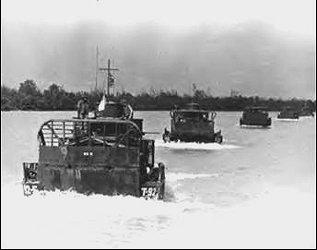

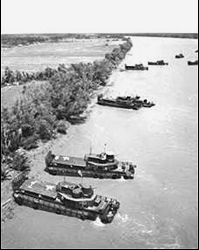

Riding the Tangos became routine for us in the Mobile Riverine Force (MRF) (a joint Army/Navy operation meant to interdict Viet Cong forces in the delta), as this was the usual method to insert troops into the jungles of the Mekong Delta. ‘Routine’ when your day consists of carrying heavy gear in a sweat zone. There was a very valid reason that, we, the combat infantryman of Vietnam were called (and called ourselves) “Grunts”.
By the way, to clarify the definition of the word ‘interdict’ (as used in the above paragraph), in the military dictionary it means to delay or disrupt enemy forces or supplies. However, I always liked the more popular phrase of the day: “Search and Destroy”.
The Vietnam Mekong Delta had become a very unique theater of operations in the whole history of warfare. The Mobile Riverine Force was an unusual symbiosis of Army and Navy elements. There were few working roads in the delta; it was essentially roadless; nearly all travel was done through the thousands of miles of riverways that webbed throughout the entire delta area. The Mobile Riverine Force had the mission of denying the Viet Cong the use of not only the main riverways but also the myriad of canals and streams that made up the Mekong river delta.
For added perspective, in the greater part of the Mekong Delta, we were operating (or playing our game) in the enemy’s ‘hometown arena’. It may be interesting to note that this ‘arena’ held 80,000 Viet Cong players, 20,000 were combat forces divided into some 30 battalions.

Timeline � May 1967 � The strange fact surfaces that out of the approximately 450,000+ US
troops in all of Vietnam, only 50,000 can be used for combat ground attack operations
BROWN WATER:
At this point, I want to give the US “Brown Water” Navy bonus points for the excellence they demonstrated in doing their job. In case it is not clear, let me explain that ‘brown water’ referred to the sediment laden delta river water that flowed towards the ‘blue water’ of the ocean. Thus Brown Water Sailors practiced their ‘sailing’ skills on little boats on the angry VC infested riverways instead of from big Navy ships sitting out on the comparatively large and friendly seas. Case in point: Later in the battle of May 15th 1967, the Navy’s command and control boat (also called command and communications boats, or CCB’s for short) took a hit in the bow by a Viet Cong 57mm recoilless rifle. This weapon was a Chinese copy of a US gun from the WWII / Korean War era …go figure. Thankfully, there were no casualties on that CCB from this hit. Between all of the boats at the battle that day, the Navy had twenty 57mm rounds fired at them from Charlie, this was the only hit. I know that I would not want to have been on that boat that was hit but I equally would not have been too keen on being on one of those boats as near misses explode nearby.
The Viet Cong were not stupid. Putting the CCB out of commission could, in theory, muddle up the Navy’s effort in blocking any retreat the VC might need to make across one of the many side rivers or streams. This was a type of military thinking that all armies do, i.e., cut off the head of the snake and the rest of the snake is no longer able to coil around you. However, the VC, perhaps, did not know that the Navy had deployed two CCB’s for this action that day. And, furthermore, to our tactical superiority, the real command and control of the entire battle was from Hueys that were above it all where the Battalion Commanders had full supervision of the entire operation.


CCB’s were really a version of the standard Monitor boat. While the Tangos carried a fair amount of weaponry, the Monitors were designed purely for maximum firepower. They were called ‘Monitors” due to their resemblance to the famous Civil War ironclad. Brown Water sailors saw the Monitor boats as the battleship of the Riverine fleet. I, as an infantryman, thought of them more as a floating tank as they carried large 20mm and 40mm guns, cannons really. With its large barrel emerging from a giant turret it reminded me of the Howitzer on our land based Army tanks.
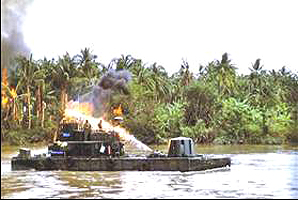
Also, it was in 1967 that we saw the introduction of “Zippo” boats. The first Zippos were converted ATC’s (Tangos), later changed to converted Monitors. The name ‘Zippo’ came from the fact that the boat had a flamethrower ability by shooting compressed napalm from a nozzle, and it could blaze up the jungle at the shore of the river. I always thought the boat was dubbed ‘Zippo’ due to the obvious connection to the Zippo cigarette lighter since they both created a flame. I later found out that, while the name ‘Zippo’ was associated to the Zippo lighter, it came from the less obvious fact that when the flame-thrower’s electronic igniter failed to work, navy operators would often have to light the thing off, at the nozzle, with their personal Zippo cigarette lighters. You could always recognize sailors that were part of a Zippo crew because they had no arm hair.
The “Zippo” crew often observed that the other boats would usually keep clear of them in battle, probably because they carried large quantities of Napalm and compressed air tanks in their boat.
I guess, though, that these Zippo boats gave a new meaning to the phrase “fire fight”.
The Navy had 22 Tangos involved that day. Their first job, of course, was to transport us, the grunts, to the patrol area (and to hopefully take us back when the operation was over). However, their second job was to support the operation with their weaponry.
Later, while performing a blocking action on the Rach Tra Tan River (really not much more than a stream to the east of our position), an ATC (Tango) wandered into a lot of VC automatic weapons fire from a heavily fortified position on the shore. Here, the Navy suffered six wounded in action on that one boat, and for all I know this could have been the very Tango crew that brought me into the battle area earlier that day. US sailors didn’t just always sit off shore in the safety of their big ships.
THE THING IS:
Towards the end of our training at Fort Riley, many of us separated in our training and given some specialty education on certain different weapons. Some of us were to be riflemen, some grenadiers, some machine gunners, etc. As for myself, I was given specialty training on the heavy M67 90mm recoilless rifle. Accordingly, this was to be my main weapon once we got to Vietnam.
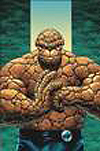
The 90mm was a large anti-tank weapon. To those not familiar with it, it looked (and acted) like a big Bazooka, but it was more powerful. It was essentially a portable breech-loaded cannon capable of being carried into battle by one man. In fact, the cartridges for the “90” looked just like conventional artillery-shells. I called it “The Thing” in reference to a fictional comic book character from my earlier youth. “The Thing”, from the cover and pages of the comic book, was a member of the superhero team known as the “Fantastic Four”. Beware evil doers.
Artwork for the cover of The Thing vol. 3, #1 (Jan, 2006), by Andrea De Vito.
The M67 90mm Recoilless Rifle did not look anything like the orange, rocky, cartoonish “Thing” in the comics, but I named this weapon after “The Thing” more for his (its?) battle cry: “It’s clobberin’ time!”


The ‘thing’ was carried and fired by one man, but it was really operated by a three-man crew – the gunner, the loader and the ammo bearer. The gunner would aim and fire after the loader inserted one of the large cartridges into the rear opening and closed the breech. It was then necessary for the loader to let the gunner know that the gun was locked and loaded, and was ready to fire, and that the backblast area was clear. To communicate the gun’s readiness to fire to the gunner, the loader was to knock on or slap the helmet of the gunner. I don’t believe this was actually in the manual, it wasn’t official doctrine, but I had guessed the “helmet rap” communication developed for one of two possible reasons or both: One – someone had correctly assumed that there might be a lot of noise on the battlefield, inhibiting verbal communications, Two – (and perhaps more correctly to my view) maybe it was the realization that the gunner and loader may both be on the doorstep of becoming deaf from the horrendous noise the ‘thing’ put out whenever it was fired. This weapon was “proud to be loud” and we were hugging close when it fired. Yes, we were given earplugs to wear, but really ..what were they thinking? In any case, there was no confusion with this helmet-slap signal, no misunderstood words or the like.
The weapon’s ‘backblast’ is a spectacular thing in itself. When the 90 fired, the propellant blast would follow the projectile out of the barrel, like a normal gun. However, to allow the 90 to remain recoilless, a large portion of the propellant gas (and shockwave) was allowed to escape out the rear. This created a danger zone up to about 30 meters behind the gun, at about a 120 degree angle. It could easily kill someone to the rear within the first 15 meters, and create serious casualties within the second 15 meter zone.
You might think, “What can be better than a portable artillery piece or a hand-carried tank?” But as much firepower as the “90” possessed, it was not an easy weapon to support logistically. Moreover, in the 115-degree heat of the jungle swamps, the “hump and jump” factor simply made the 90 not well suited for jungle patrols or river crossings and the like. Moreover, as far as I knew, the VC did not have tanks in the Mekong Delta.

Hell, our own US Army tanks that ventured out into the delta would easily and often get caught in the soft mud. The delta was not a place for tanks. However, the Army had special tank recovery crews with special cranes and other machinery and accordingly there were times we had to be sent out to protect the tank rescuers as they tried to extricate the stuck tanks from the omnipresent mud. The picture above is one that I took while on one such mission.
